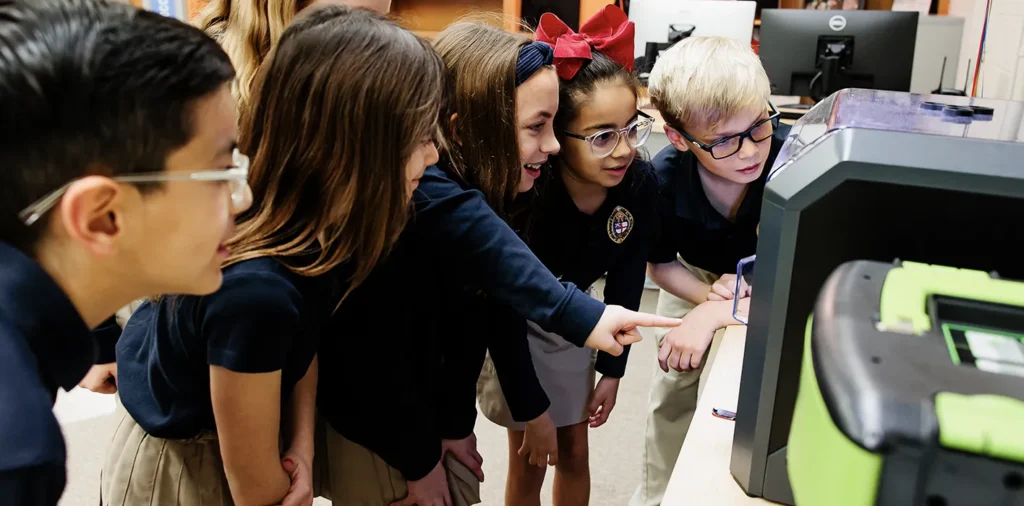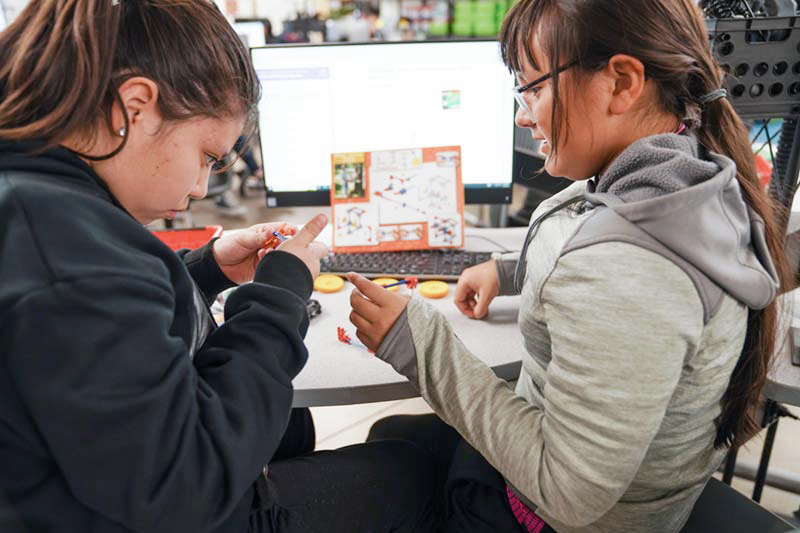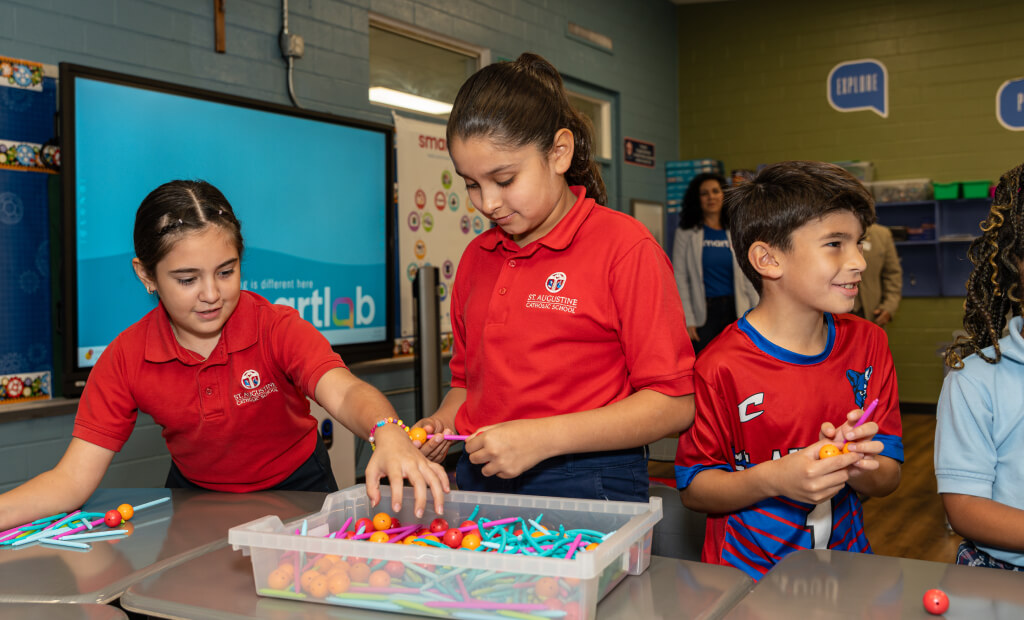Beyond Calculators: Integrating Technology into Math Classrooms for Enhanced Learning Experiences
When we discuss the benefits of science, technology, engineering, and mathematics (STEM) education, it’s important to remember that these are meant to work together rather than in isolation.
In that regard, it’s natural to think of technology and math as easily integrated — after all, it’s right there in the name STEM. The truth is that, while technology offers many potential benefits for education, it can too often be used as a simple tool for passive learning. The last thing we want is for technology to be used as a way to avoid math rather than engage with it.
There are ways to thoughtfully integrate technology into a classroom that go beyond the use of calculators to solve problems. Continue reading for our thoughts on how you can employ innovative tools and techniques to enhance teaching efficiency and student engagement.
Introduction to Technology in Math Education
Both the Association of Mathematics Teacher Educators (AMTE) and the National Council of Teachers of Mathematics (NCTM) have highlighted the importance of integrating modern tools and technology into mathematics education.
The NCTM suggests that math programs should integrate “the use of mathematical tools and technology as essential resources to help students learn and make sense of mathematical ideas, reason mathematically, and communicate their mathematical thinking.” However, this needs to be more than the integration of technology for its own sake.
While great progress has been made in closing the previous digital divide to provide more students with access to technology, there is a risk that technology can be used as a tool for passive learning rather than helping learners engage in active learning experiences that promote student agency.
In Principles to Actions: Ensuring Mathematical Success for All, the NCTM clarifies that, “the value of the technology depends on whether students actually engage with specific technologies or tools in ways that promote mathematical reasoning and sense making.” Technology can’t be used as simply a quick way to arrive at answers or as a “reward” for first doing the calculations by hand.
Content-neutral technology that promotes fast answering is more about promoting memorization, not thinking deeply, discovering patterns, or making necessary connections. Technology should be seen as a tool to help students realize their agency in deciding what strategies they want to use and how they might solve a problem.
Benefits of Integrating Technology with Math
So, how should we approach integrating technology into math, and what are the outcomes? We can look to the AMTE’s Position of the Association of Mathematics Teacher Educators on Technology as a guide, where they suggest five interconnected ways educators should incorporate technology:
- For the purpose of advancing equity and equitable teaching practices
- To assist in developing educators’ mathematical content knowledge
- To support students’ learning and understanding of mathematics
- As a platform for supporting online, hybrid, and distance education
- As a part of regular self-evaluations about how the technology is used and the ways it supports learning
Through this integrated and thoughtful approach, effective technology use in math can result in:
- More ways for learners to engage with the material, including alternative means of understanding the concepts and process of mathematics
- Increased opportunities for collaboration, regardless of learners’ physical locations
- More accurate simulations of real-world scenarios that can tie into job skills training
- Greater accessibility for students through more personalized learning that allows learners to set their own pace and receive tailored guidance and feedback
- Faster response times for educators thanks to the ability to instantly collect data, assess work and give immediate feedback
Key Technological Tools for Math Classrooms
What technologies should educators look to? Any thoughtful integration will require a mix of tools and devices that educators can use to connect with students in addition to grade-appropriate applications that tie directly into the curriculum.
There are a lot of options out there, for both physical and virtual classrooms, so here are a few essential categories to consider along with some specific recommendations.
- Hardware and collaborative technology
- Tablets and computers
- Digital projectors
- Interactive whiteboards — Explain Everything or Miro
- Presentation software — NearPod or KeyNote
- Screencasting tools — Loom or Screencastify
- Interactive online tools and games — Kahoot or Quizlet
- Educational math games — Prodigy, Mathletics or DoodleMath
- Math manipulatives, including Math-specific software and applications
- Physical visualization tools — Lux Blox Rekenreks, Dominoes or Number lines
- Virtual visualization tools — Geoboards, Number charts
- Computer algebra systems (CAS) — MathCAD
- Data analysis applications — Google Sheets or Excel
You can also explore different math applications at sites such as the Math Learning Center, Desmos Studios, GeoGebra, or the tools available in SmartLab Learning Hub.
Integrating Tech with Curriculum

There are several approaches to integrate technology into a math curriculum, but it should start with an eye toward active learning. The goal should always be to encourage learners to engage with the problem, not just passively use technology or rely on rote memorization. Consider the following:
- Prioritize Software Built on Active Learning — You can use technology like Desmos or GeoGebra to encourage students to experiment, visualize, and manipulate functions or geometric shapes. This approach will help learners develop critical thinking skills and apply mathematical concepts in real-time, instead of merely following a set of steps.
Platforms such as Kahoot or Quizlet can be used for real-time problem-solving quizzes. These tools allow learners to make mistakes and receive immediate feedback, fostering a growth mindset and encouraging productive struggle as part of the learning process. - Employ Gamification Techniques — Websites with math games can add elements of fun and competition by awarding points, badges, or rankings to lessons, motivating learners to persist in solving challenging problems. You can also implement collaborative math games where learners can strategize and work together to solve problems and win.
Free to use platforms examples include Prodigy Math, where learners play as wizards in math battles or Euclidea, which is an app that presents geometry as interactive puzzles. - Build Digital Math Communities — Create online spaces where learners can collaborate on math problems, share resources, and ask questions. These peer-learning environments encourage student-led discussion on forums and give them more opportunities to work together on group tasks. These spaces can also provide educators’ tools to allow for immediate insights and feedback.
Platforms like Google Classroom, Microsoft Teams, or a more specialized learning management system (LMS) like Canvas can be used to set up spaces where students can collaborate in real-time on group tasks and where peer mentors (students who excel in math) can help moderate or guide discussions — for example, in a statistics class, students can collectively analyze a data set, with each group responsible for different parts of the analysis. - Employ Visualization, Simulation, and Modeling Tools — In its examination of mathematical action technologies, the NCTM explains,“The ability to shift between different representations of a problem (e.g., visual/graphical, symbolic, numerical) can help students develop a deeper understanding of mathematical concepts.” Tools that allow students to visualize complex math concepts help to make abstract concepts more tangible, helping students grasp the “why” behind procedures.
These applications can also demonstrate real-world applications of mathematics, such as using a program to create representations of a large data set to explore relationships and draw conclusions. This can demonstrate how we can apply math concepts in practical ways that are relevant to future careers or even everyday activities. - Build Tech Skills Alongside Math Skills — Knowing how to use technology, especially new or unfamiliar technology, to enhance their problem-solving is an important skill unto itself. Using math problems as an opportunity to teach students how to use the technology effectively is a great way to help prepare learners for 21st century careers and responsibilities.
To help make math situations more relevant to learners’ lived experiences, you could employ project-based learning (PBL) activities to present students with a problem they need to solve through thoughtful inquiry, collaboration, self-reflection, and the use of technology.
See our blog post, Innovative Approaches: Bringing Math to Life Through Project-Based Learning, for tips and examples of how to bring PBL into the math curriculum.
Challenges and Considerations
- How to choose the right technology?
Always keep in mind that you don’t want to use technology just for its own sake. Don’t think of pedagogy, content, and technology as separate entities, but as intersecting domains that you need to integrate into the curriculum. You’ll need to do some research (or consult with peers and experts) about which tools will be most appropriate for which grade levels. We recommend starting your search with the applications and tools linked out within this blog.
- How to ensure equitable access to technology for all students?
It’s important to invest in resources that ensure all students receive the support they need in order to succeed. Technology that enables more personalized learning can provide greater equity among learners. To determine personalized learning needs:- You could start with a KWL chart as a formative assessment to see what learners Know, what they Want to know, and what they have Learned.
- If you’re looking to utilize different forms of assessment to see where learners are, Consider these approaches from Edutopia.
- When looking at different digital apps and websites, see what they offer for personalized learning. Commonsense.org has a helpful list of sites and tools that prioritize personalized learning.
Interested in more tips and advice about how to approach assessment in the inquiry-centered classroom?
We recommend reading these additional articles:
- How to manage concerns over excessive screen time and data privacy?
If parents are concerned about screen time or privacy, be sure to inform them that the lessons use technology purposefully, focusing on interactive, problem-solving tasks rather than passive use. For data privacy, be sure to choose secure, education-specific platforms that comply with data protection regulations (like FERPA or COPPA). You can also use the opportunity to educate students on safe online practices and ensure that parental consent is obtained for any app or tool collecting data.
- How to afford the technology?
If school budgets are tight, you can search for additional funding sources. You can look for grants that support STEM education and/or the use of technology in school, or for funds created to support certain demographics, such as under-served communities. Read our recommendations on how to secure long-term funding for STEM initiatives. Will describe and refer readers to the funding guide when it’s up (estimated Sept. 14th)
See how one Denver school utilized the technology within SmartLab to help improve student engagement with math: Read the Case Study.
The Future of Math Education with Technology
As technology progresses, it’s likely to play an increasingly integrated role in all areas of education — including mathematics. Some things to consider:
- While the flipped learning module isn’t a new concept in education, there is evidence that it can be an effective approach in teaching foundation-year mathematics. In these scenarios, the use of technology, such as screencasting software and content creation apps for tablets, can make the flipped model more easily accessible for students and provide educators with important tools and resources.
- We’re already seeing advances with common math apps, such as Apple’s Ipad Calculator with Math Notes that comes with the Apple iOS 18 update. The Math Notes feature allows users to type or write out mathematical expressions and see them instantly solved in their own handwriting. Learners can even write or type out multiple equations and insert them into a graph with a tap. If your school provides Apple devices to learners, experiment with these features to see how they can be incorporated into lessons.
- As artificial intelligence continues to evolve, we’re already seeing its integration into adaptive learning tools that tailor instruction based on student performance. For example, platforms like DreamBox and ALEKS are leveraging AI to provide personalized feedback, helping educators identify gaps in understanding. According to the NCTM, AI-driven tools can support deep mathematical reasoning when used to complement teacher instruction, rather than replace it.
- We’re likely still years away from schools using interactive, virtual environments on a regular basis for their curriculum — but there are organizations working on making virtual reality a feasible tool for improving accessibility to math education. Immersive technology has been shown to help with mathematics geometry learning, so expect to see more developments with VR in the near future.
If you’re looking to stay updated with the latest tools and methodologies available for mathematics education, keep an eye on our blog as we continue to explore the important role that technology plays in STEM education.



